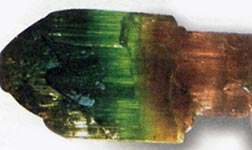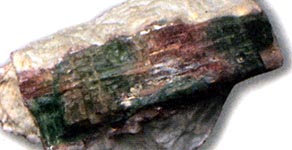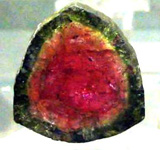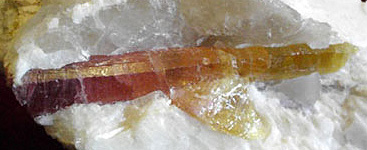TOURMALINE


 Characteristics of the mineral.
Characteristics of the mineral.
Aluminosilicate with a complex composition. The term tourmaline is used today to refer to a whole class of similar minerals that, when viewed more closely, act as independent entities. The most remarkable feature of this mineral is its polychrome - multicolor. In this case, the colors vary from blue and green to pink and colorless.
The wide popularity of tourmaline is connected, first of all, with the beauty of the diverse colors of its various transparent varieties: rubellite - pink or red; Sibirite, or daurite, - cherry red; Indigolite - blue, blue; Verdelit - green; Dravit - brown, yellow, brown; Achroit - colorless; Chameleonite - olive green in daylight, brownish red - with artificial; Chrome-tourmaline - emerald green. Polychrome tourmalines with a transversely banded or concentric zonation are quite widely developed. In this case, the color changes from blue and green to colorless and pink. The most common are green and pink. Sometimes in polychromic tourmalines with a cross-banded color variation along the elongation of the crystals, not only the indicated color changes are noted, but also the transitions from colorless to black at the ends. Such crystals are found on the island. Elbe. Color tourmalines (pink, green and yellow) are called elbaites.
Of course, the most spectacular are pink, red, crimson, cherry tourmaline - rubellite. Today we have learned to artificially receive tourmalines, but synthetic tourmalines do not have much importance. Their natural reserves are quite sufficient. The largest cluster of rubellite crystals found in Brazil, its mass was about 4 tons. The largest crystal in the cluster was 40 cm in length. They also obtained a crystal, considered to be the largest among the known, its length is 100 cm and 40 cm across. In Russia, deposits of tourmaline are found in Transbaikalia.
Tourmaline belongs to the number of precious stones, well known long ago and widely used throughout the world. The wide popularity of tourmaline is associated, first of all, with the beauty of the diverse colors of its various transparent varieties. The chemical composition of tourmalines determines coloration and their other physical properties. The glitter of tourmaline is glassy, the hardness is 7-7.5. Fragile. Cleavage is absent. Blue, blue, green, yellow, orange, brown, brown to black and shades of iron tourmaline are due to iron ions. Emerald green color is determined by the content of chromium ions. Pink, red coloration is caused by manganese ions.
Jewelery tourmalines are known on. Sri Lanka (yellow and brown twisted and dravity), in Burma (pink elbaites), Brazil (elbaits of various colors, including polychrome), India - in pcs. Jammu and Kashmir (green elbaites), Namibia (green chrome-tourmaline, green and pink elbaites), Zimbabwe (pure elbaites), Mozambique (elbaites with delicate coloration in various colors, polychrome), in Madagascar (polychrome liddicoautites with concentric-zonal coloration ), Tanzania (green elbaites), Kenya (red and brown-red dravits), the USA in the states of California (pink elbaites), Maine (green, bluish-green, blue, pink and red elbaites), Connecticut (polychrome elbaites) , New Mexico and New Jersey (Dravity), as well as in Afghanistan (Nuristan).
Prices for tourmaline of different colors are not stable. When processing tourmaline is often used step cut, less often diamond or fancy. Polychrome tourmaline and stones with asterism cabochon.
Magical properties.
Beneficially affect the body and mind. A talisman of love and victory, hope, unfading youth and strength. Stones are talismans from evil eye, spoilage, harmful entities and people. They protect artistic natures from fruitless throwing, give recognition and strength of execution of ideas. Pink tourmaline is the keeper of love. He relieves suffering and fear. Raspberry tourmaline is considered a talisman of artists, it gives creative strength and brings recognition. Green absorbs and cools passions. Variegated tourmaline - half green, half red, a stone of creative and erotic impulses, retains youth and strength in man. And, finally, black tourmaline - the sherlock is considered a stone of witches or widows. The most magical is the red tourmaline, bringing happiness and success in love to men, increasing their energy and strengthening their potency.








Poisonous and radioactive dangerous stones and minerals
** - poisonous stones and minerals (mandatory check in the chemical laboratory + explicit indication of toxicity).
** - radioactive stones and minerals (mandatory check on the standard dosimeter + ban on open sales in the case of radioactivity over 24 milli / g / h + additional measures of population protection).
All rare stones are subject to mandatory inspection at the standard dosimeter for the permissible level of radiation and in the chemical laboratory for the absence of poisonous and evaporating components that are dangerous to humans and the environment.


Comments
When commenting on, remember that the content and tone of your message can hurt the feelings of real people, show respect and tolerance to your interlocutors even if you do not share their opinion, your behavior in the conditions of freedom of expression and anonymity provided by the Internet, changes Not only virtual, but also the real world. All comments are hidden from the index, spam is controlled.